Business Research Report: Tourism in Manang District, Nepal
VerifiedAdded on 2020/03/01
|12
|2823
|291
Report
AI Summary
This business research report examines the factors driving the growth of the tourism industry in the Manang district of Nepal. The research aims to assess the business scenario, evaluate customer satisfaction strategies, analyze the impact of tourism packages on stakeholders, and suggest recommendations for expansion. The report analyzes three journal articles, exploring topics such as ecotourism, conservation, willingness to pay, and tourism development in the Annapurna region. It uses both qualitative and quantitative research methods, including surveys and interviews, to gather data. The study highlights the importance of ecotourism, infrastructural improvements, customer satisfaction, and sustainable practices for the continued growth of the tourism sector in the region. The report also discusses the research approaches, strategies, and methods employed in each article, providing a comprehensive overview of the tourism industry's development in Manang.
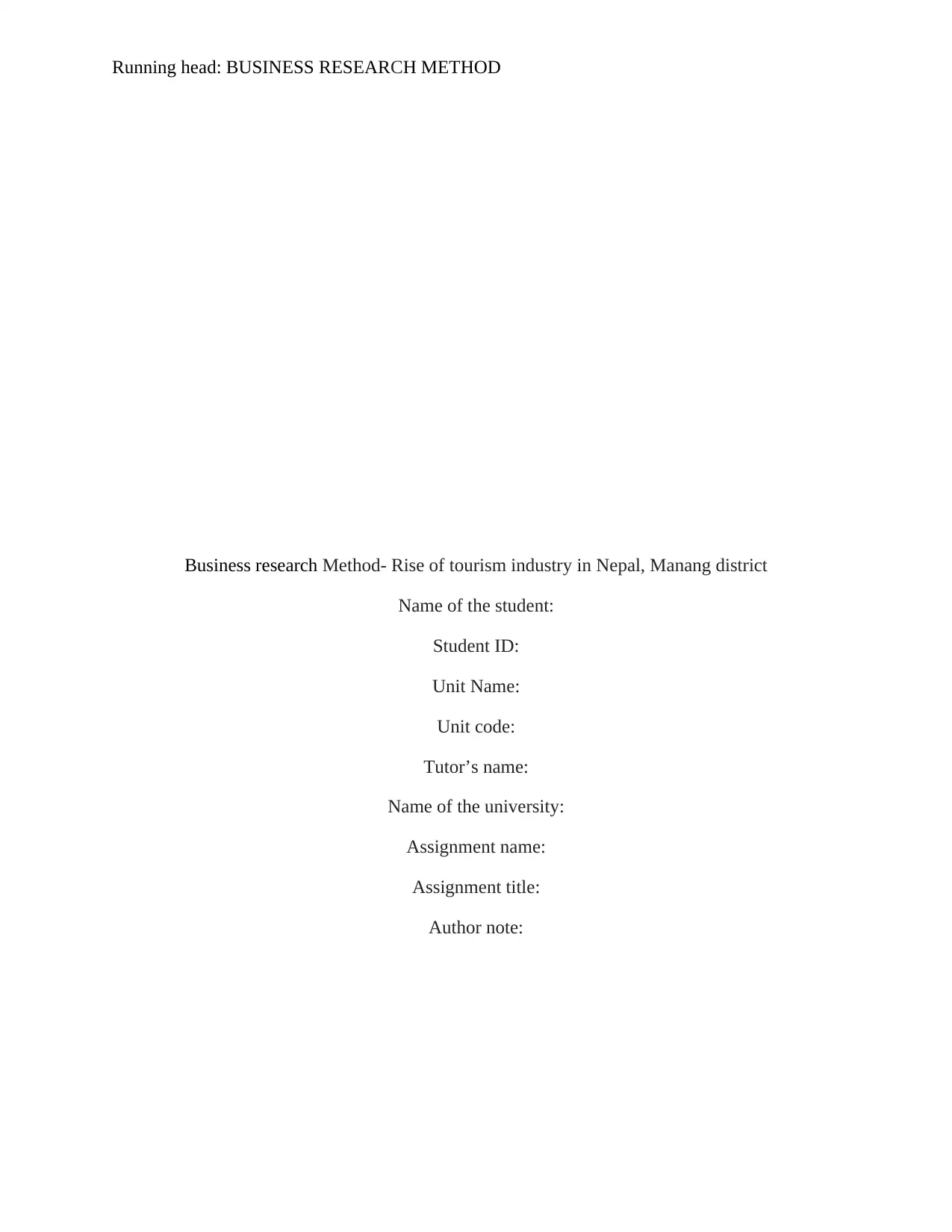
Running head: BUSINESS RESEARCH METHOD
Business research Method- Rise of tourism industry in Nepal, Manang district
Name of the student:
Student ID:
Unit Name:
Unit code:
Tutor’s name:
Name of the university:
Assignment name:
Assignment title:
Author note:
Business research Method- Rise of tourism industry in Nepal, Manang district
Name of the student:
Student ID:
Unit Name:
Unit code:
Tutor’s name:
Name of the university:
Assignment name:
Assignment title:
Author note:
Secure Best Marks with AI Grader
Need help grading? Try our AI Grader for instant feedback on your assignments.
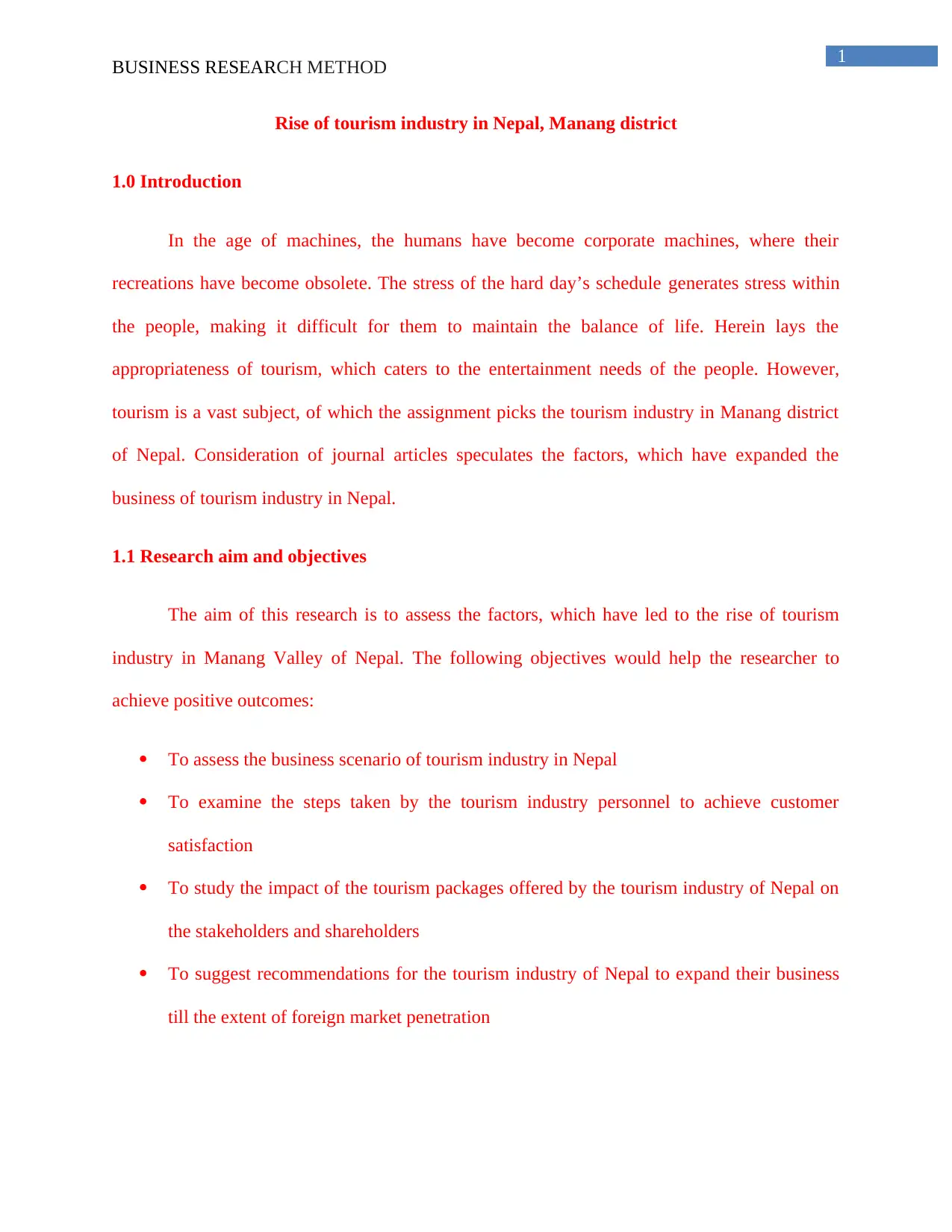
1
BUSINESS RESEARCH METHOD
Rise of tourism industry in Nepal, Manang district
1.0 Introduction
In the age of machines, the humans have become corporate machines, where their
recreations have become obsolete. The stress of the hard day’s schedule generates stress within
the people, making it difficult for them to maintain the balance of life. Herein lays the
appropriateness of tourism, which caters to the entertainment needs of the people. However,
tourism is a vast subject, of which the assignment picks the tourism industry in Manang district
of Nepal. Consideration of journal articles speculates the factors, which have expanded the
business of tourism industry in Nepal.
1.1 Research aim and objectives
The aim of this research is to assess the factors, which have led to the rise of tourism
industry in Manang Valley of Nepal. The following objectives would help the researcher to
achieve positive outcomes:
To assess the business scenario of tourism industry in Nepal
To examine the steps taken by the tourism industry personnel to achieve customer
satisfaction
To study the impact of the tourism packages offered by the tourism industry of Nepal on
the stakeholders and shareholders
To suggest recommendations for the tourism industry of Nepal to expand their business
till the extent of foreign market penetration
BUSINESS RESEARCH METHOD
Rise of tourism industry in Nepal, Manang district
1.0 Introduction
In the age of machines, the humans have become corporate machines, where their
recreations have become obsolete. The stress of the hard day’s schedule generates stress within
the people, making it difficult for them to maintain the balance of life. Herein lays the
appropriateness of tourism, which caters to the entertainment needs of the people. However,
tourism is a vast subject, of which the assignment picks the tourism industry in Manang district
of Nepal. Consideration of journal articles speculates the factors, which have expanded the
business of tourism industry in Nepal.
1.1 Research aim and objectives
The aim of this research is to assess the factors, which have led to the rise of tourism
industry in Manang Valley of Nepal. The following objectives would help the researcher to
achieve positive outcomes:
To assess the business scenario of tourism industry in Nepal
To examine the steps taken by the tourism industry personnel to achieve customer
satisfaction
To study the impact of the tourism packages offered by the tourism industry of Nepal on
the stakeholders and shareholders
To suggest recommendations for the tourism industry of Nepal to expand their business
till the extent of foreign market penetration
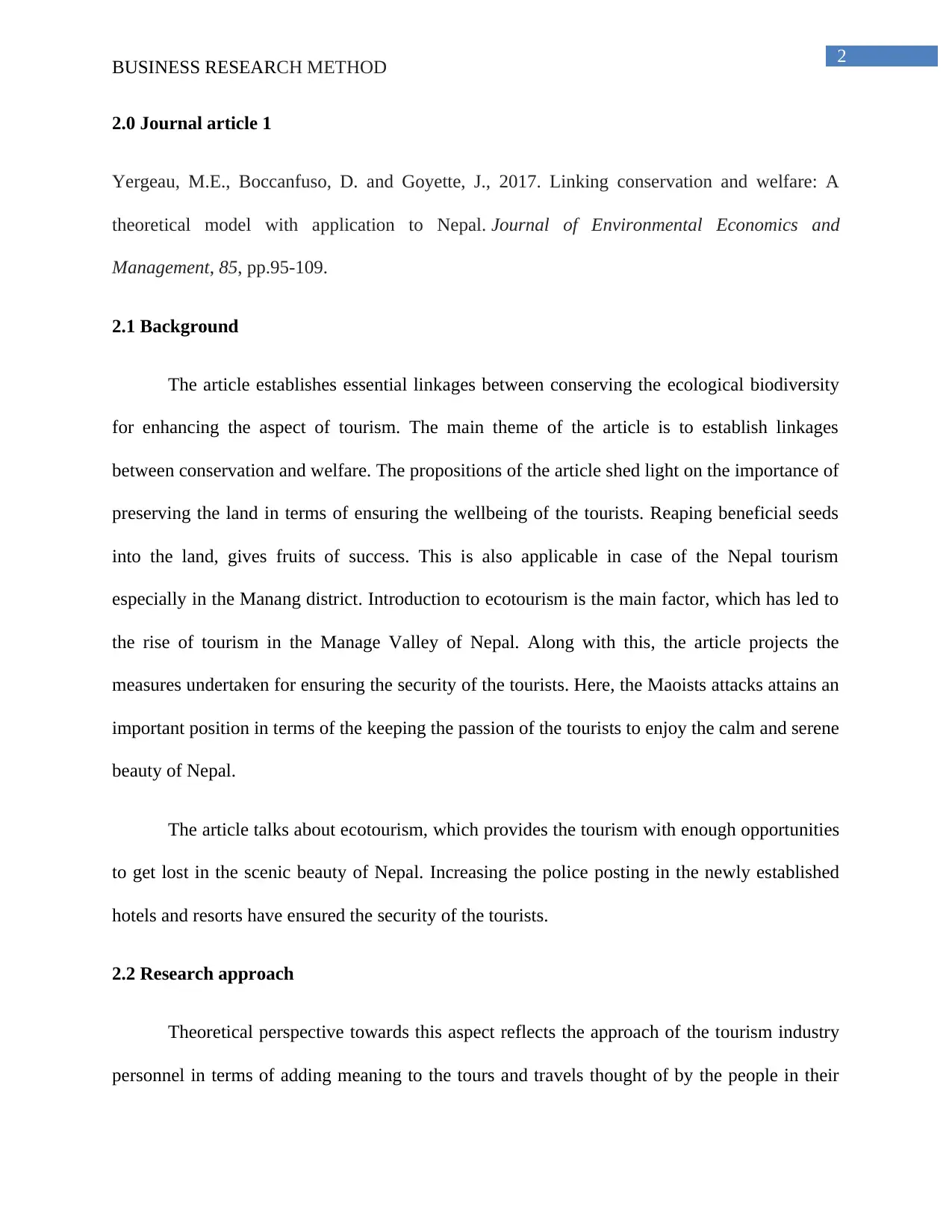
2
BUSINESS RESEARCH METHOD
2.0 Journal article 1
Yergeau, M.E., Boccanfuso, D. and Goyette, J., 2017. Linking conservation and welfare: A
theoretical model with application to Nepal. Journal of Environmental Economics and
Management, 85, pp.95-109.
2.1 Background
The article establishes essential linkages between conserving the ecological biodiversity
for enhancing the aspect of tourism. The main theme of the article is to establish linkages
between conservation and welfare. The propositions of the article shed light on the importance of
preserving the land in terms of ensuring the wellbeing of the tourists. Reaping beneficial seeds
into the land, gives fruits of success. This is also applicable in case of the Nepal tourism
especially in the Manang district. Introduction to ecotourism is the main factor, which has led to
the rise of tourism in the Manage Valley of Nepal. Along with this, the article projects the
measures undertaken for ensuring the security of the tourists. Here, the Maoists attacks attains an
important position in terms of the keeping the passion of the tourists to enjoy the calm and serene
beauty of Nepal.
The article talks about ecotourism, which provides the tourism with enough opportunities
to get lost in the scenic beauty of Nepal. Increasing the police posting in the newly established
hotels and resorts have ensured the security of the tourists.
2.2 Research approach
Theoretical perspective towards this aspect reflects the approach of the tourism industry
personnel in terms of adding meaning to the tours and travels thought of by the people in their
BUSINESS RESEARCH METHOD
2.0 Journal article 1
Yergeau, M.E., Boccanfuso, D. and Goyette, J., 2017. Linking conservation and welfare: A
theoretical model with application to Nepal. Journal of Environmental Economics and
Management, 85, pp.95-109.
2.1 Background
The article establishes essential linkages between conserving the ecological biodiversity
for enhancing the aspect of tourism. The main theme of the article is to establish linkages
between conservation and welfare. The propositions of the article shed light on the importance of
preserving the land in terms of ensuring the wellbeing of the tourists. Reaping beneficial seeds
into the land, gives fruits of success. This is also applicable in case of the Nepal tourism
especially in the Manang district. Introduction to ecotourism is the main factor, which has led to
the rise of tourism in the Manage Valley of Nepal. Along with this, the article projects the
measures undertaken for ensuring the security of the tourists. Here, the Maoists attacks attains an
important position in terms of the keeping the passion of the tourists to enjoy the calm and serene
beauty of Nepal.
The article talks about ecotourism, which provides the tourism with enough opportunities
to get lost in the scenic beauty of Nepal. Increasing the police posting in the newly established
hotels and resorts have ensured the security of the tourists.
2.2 Research approach
Theoretical perspective towards this aspect reflects the approach of the tourism industry
personnel in terms of adding meaning to the tours and travels thought of by the people in their
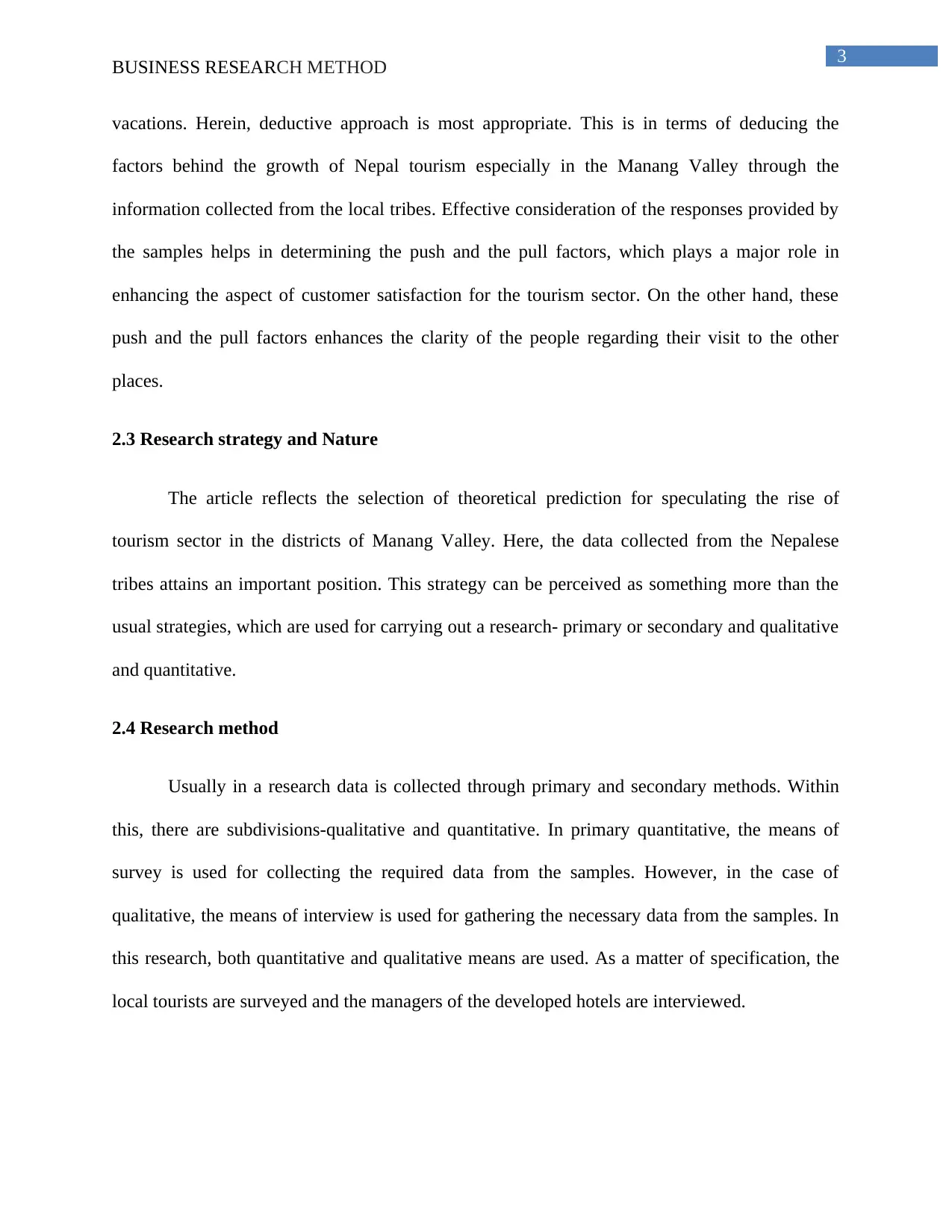
3
BUSINESS RESEARCH METHOD
vacations. Herein, deductive approach is most appropriate. This is in terms of deducing the
factors behind the growth of Nepal tourism especially in the Manang Valley through the
information collected from the local tribes. Effective consideration of the responses provided by
the samples helps in determining the push and the pull factors, which plays a major role in
enhancing the aspect of customer satisfaction for the tourism sector. On the other hand, these
push and the pull factors enhances the clarity of the people regarding their visit to the other
places.
2.3 Research strategy and Nature
The article reflects the selection of theoretical prediction for speculating the rise of
tourism sector in the districts of Manang Valley. Here, the data collected from the Nepalese
tribes attains an important position. This strategy can be perceived as something more than the
usual strategies, which are used for carrying out a research- primary or secondary and qualitative
and quantitative.
2.4 Research method
Usually in a research data is collected through primary and secondary methods. Within
this, there are subdivisions-qualitative and quantitative. In primary quantitative, the means of
survey is used for collecting the required data from the samples. However, in the case of
qualitative, the means of interview is used for gathering the necessary data from the samples. In
this research, both quantitative and qualitative means are used. As a matter of specification, the
local tourists are surveyed and the managers of the developed hotels are interviewed.
BUSINESS RESEARCH METHOD
vacations. Herein, deductive approach is most appropriate. This is in terms of deducing the
factors behind the growth of Nepal tourism especially in the Manang Valley through the
information collected from the local tribes. Effective consideration of the responses provided by
the samples helps in determining the push and the pull factors, which plays a major role in
enhancing the aspect of customer satisfaction for the tourism sector. On the other hand, these
push and the pull factors enhances the clarity of the people regarding their visit to the other
places.
2.3 Research strategy and Nature
The article reflects the selection of theoretical prediction for speculating the rise of
tourism sector in the districts of Manang Valley. Here, the data collected from the Nepalese
tribes attains an important position. This strategy can be perceived as something more than the
usual strategies, which are used for carrying out a research- primary or secondary and qualitative
and quantitative.
2.4 Research method
Usually in a research data is collected through primary and secondary methods. Within
this, there are subdivisions-qualitative and quantitative. In primary quantitative, the means of
survey is used for collecting the required data from the samples. However, in the case of
qualitative, the means of interview is used for gathering the necessary data from the samples. In
this research, both quantitative and qualitative means are used. As a matter of specification, the
local tourists are surveyed and the managers of the developed hotels are interviewed.
Secure Best Marks with AI Grader
Need help grading? Try our AI Grader for instant feedback on your assignments.
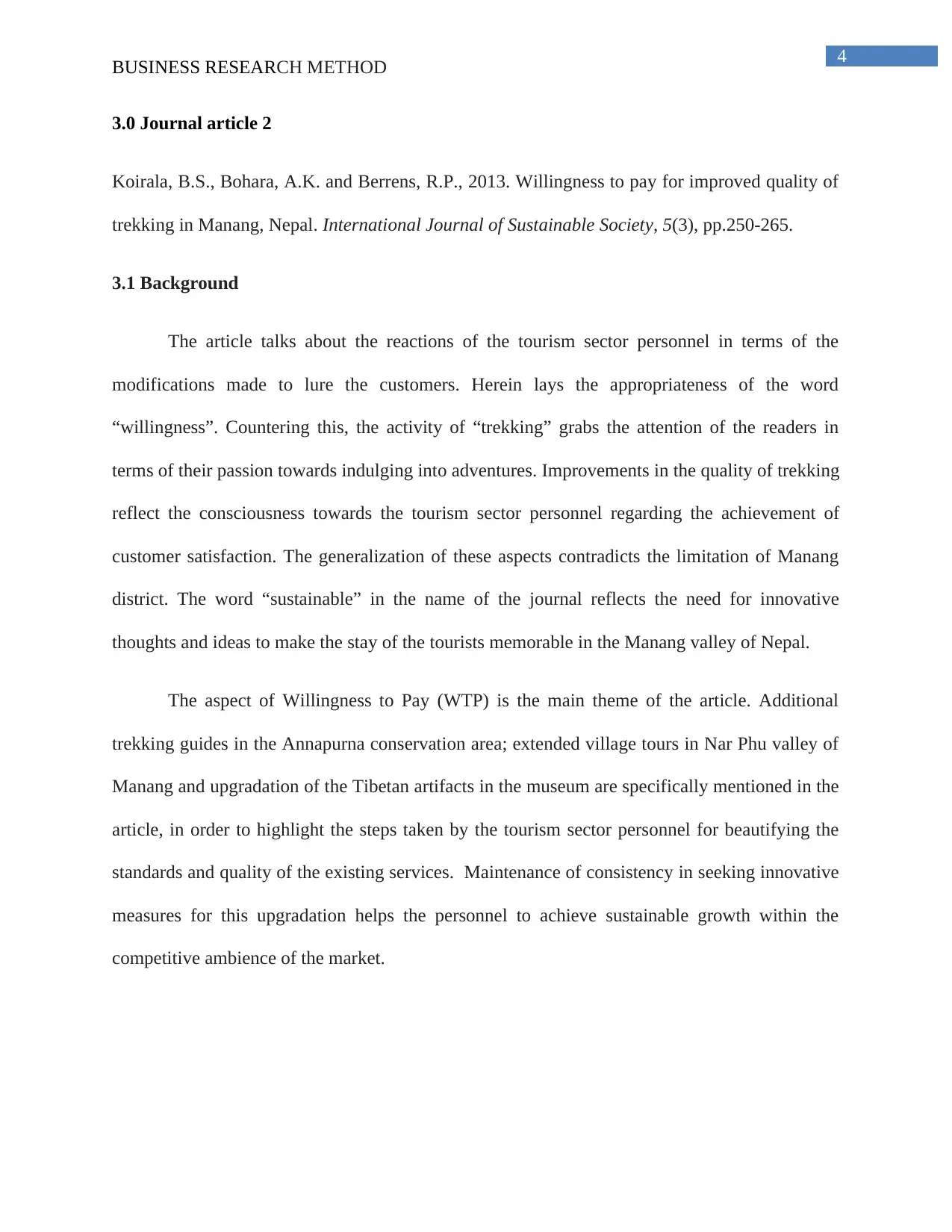
4
BUSINESS RESEARCH METHOD
3.0 Journal article 2
Koirala, B.S., Bohara, A.K. and Berrens, R.P., 2013. Willingness to pay for improved quality of
trekking in Manang, Nepal. International Journal of Sustainable Society, 5(3), pp.250-265.
3.1 Background
The article talks about the reactions of the tourism sector personnel in terms of the
modifications made to lure the customers. Herein lays the appropriateness of the word
“willingness”. Countering this, the activity of “trekking” grabs the attention of the readers in
terms of their passion towards indulging into adventures. Improvements in the quality of trekking
reflect the consciousness towards the tourism sector personnel regarding the achievement of
customer satisfaction. The generalization of these aspects contradicts the limitation of Manang
district. The word “sustainable” in the name of the journal reflects the need for innovative
thoughts and ideas to make the stay of the tourists memorable in the Manang valley of Nepal.
The aspect of Willingness to Pay (WTP) is the main theme of the article. Additional
trekking guides in the Annapurna conservation area; extended village tours in Nar Phu valley of
Manang and upgradation of the Tibetan artifacts in the museum are specifically mentioned in the
article, in order to highlight the steps taken by the tourism sector personnel for beautifying the
standards and quality of the existing services. Maintenance of consistency in seeking innovative
measures for this upgradation helps the personnel to achieve sustainable growth within the
competitive ambience of the market.
BUSINESS RESEARCH METHOD
3.0 Journal article 2
Koirala, B.S., Bohara, A.K. and Berrens, R.P., 2013. Willingness to pay for improved quality of
trekking in Manang, Nepal. International Journal of Sustainable Society, 5(3), pp.250-265.
3.1 Background
The article talks about the reactions of the tourism sector personnel in terms of the
modifications made to lure the customers. Herein lays the appropriateness of the word
“willingness”. Countering this, the activity of “trekking” grabs the attention of the readers in
terms of their passion towards indulging into adventures. Improvements in the quality of trekking
reflect the consciousness towards the tourism sector personnel regarding the achievement of
customer satisfaction. The generalization of these aspects contradicts the limitation of Manang
district. The word “sustainable” in the name of the journal reflects the need for innovative
thoughts and ideas to make the stay of the tourists memorable in the Manang valley of Nepal.
The aspect of Willingness to Pay (WTP) is the main theme of the article. Additional
trekking guides in the Annapurna conservation area; extended village tours in Nar Phu valley of
Manang and upgradation of the Tibetan artifacts in the museum are specifically mentioned in the
article, in order to highlight the steps taken by the tourism sector personnel for beautifying the
standards and quality of the existing services. Maintenance of consistency in seeking innovative
measures for this upgradation helps the personnel to achieve sustainable growth within the
competitive ambience of the market.
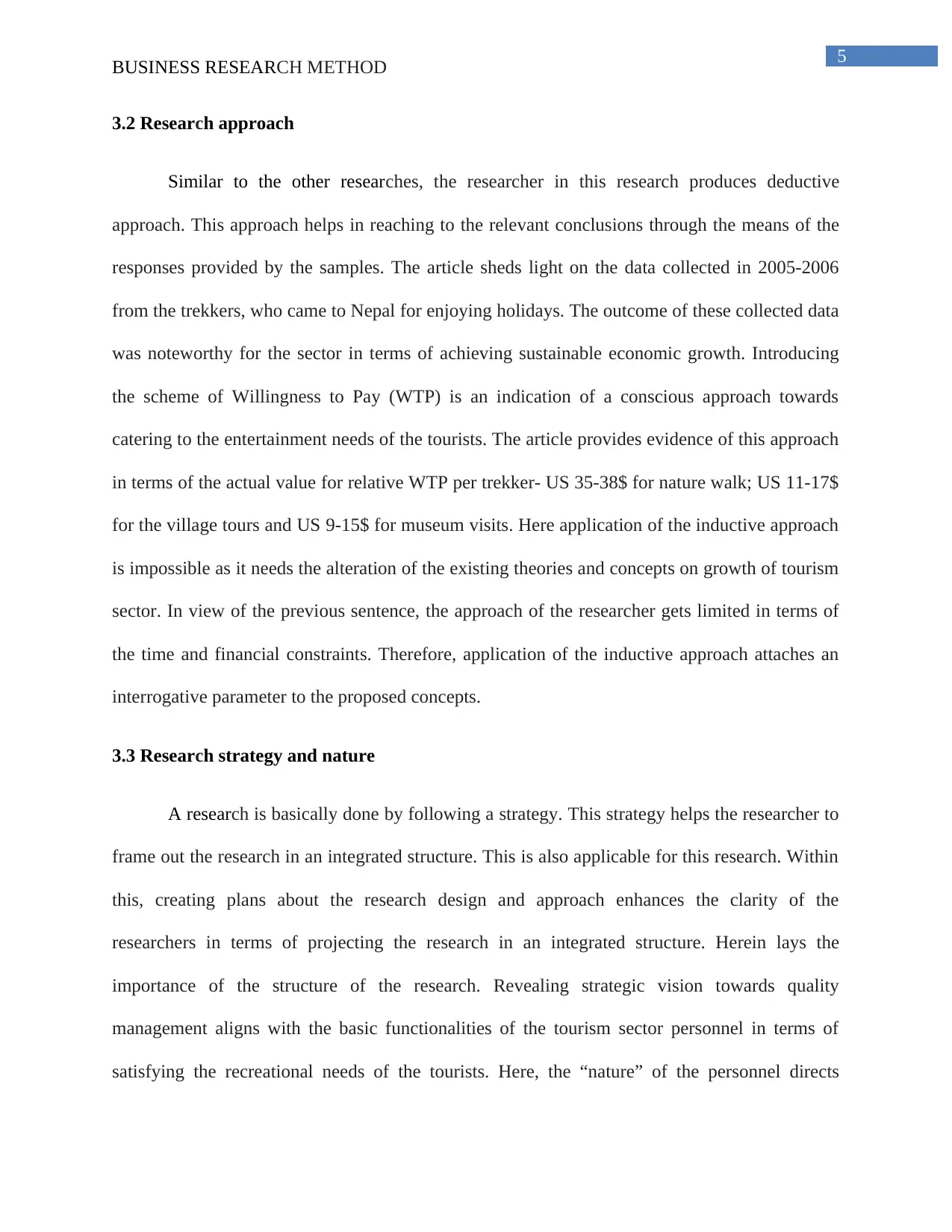
5
BUSINESS RESEARCH METHOD
3.2 Research approach
Similar to the other researches, the researcher in this research produces deductive
approach. This approach helps in reaching to the relevant conclusions through the means of the
responses provided by the samples. The article sheds light on the data collected in 2005-2006
from the trekkers, who came to Nepal for enjoying holidays. The outcome of these collected data
was noteworthy for the sector in terms of achieving sustainable economic growth. Introducing
the scheme of Willingness to Pay (WTP) is an indication of a conscious approach towards
catering to the entertainment needs of the tourists. The article provides evidence of this approach
in terms of the actual value for relative WTP per trekker- US 35-38$ for nature walk; US 11-17$
for the village tours and US 9-15$ for museum visits. Here application of the inductive approach
is impossible as it needs the alteration of the existing theories and concepts on growth of tourism
sector. In view of the previous sentence, the approach of the researcher gets limited in terms of
the time and financial constraints. Therefore, application of the inductive approach attaches an
interrogative parameter to the proposed concepts.
3.3 Research strategy and nature
A research is basically done by following a strategy. This strategy helps the researcher to
frame out the research in an integrated structure. This is also applicable for this research. Within
this, creating plans about the research design and approach enhances the clarity of the
researchers in terms of projecting the research in an integrated structure. Herein lays the
importance of the structure of the research. Revealing strategic vision towards quality
management aligns with the basic functionalities of the tourism sector personnel in terms of
satisfying the recreational needs of the tourists. Here, the “nature” of the personnel directs
BUSINESS RESEARCH METHOD
3.2 Research approach
Similar to the other researches, the researcher in this research produces deductive
approach. This approach helps in reaching to the relevant conclusions through the means of the
responses provided by the samples. The article sheds light on the data collected in 2005-2006
from the trekkers, who came to Nepal for enjoying holidays. The outcome of these collected data
was noteworthy for the sector in terms of achieving sustainable economic growth. Introducing
the scheme of Willingness to Pay (WTP) is an indication of a conscious approach towards
catering to the entertainment needs of the tourists. The article provides evidence of this approach
in terms of the actual value for relative WTP per trekker- US 35-38$ for nature walk; US 11-17$
for the village tours and US 9-15$ for museum visits. Here application of the inductive approach
is impossible as it needs the alteration of the existing theories and concepts on growth of tourism
sector. In view of the previous sentence, the approach of the researcher gets limited in terms of
the time and financial constraints. Therefore, application of the inductive approach attaches an
interrogative parameter to the proposed concepts.
3.3 Research strategy and nature
A research is basically done by following a strategy. This strategy helps the researcher to
frame out the research in an integrated structure. This is also applicable for this research. Within
this, creating plans about the research design and approach enhances the clarity of the
researchers in terms of projecting the research in an integrated structure. Herein lays the
importance of the structure of the research. Revealing strategic vision towards quality
management aligns with the basic functionalities of the tourism sector personnel in terms of
satisfying the recreational needs of the tourists. Here, the “nature” of the personnel directs
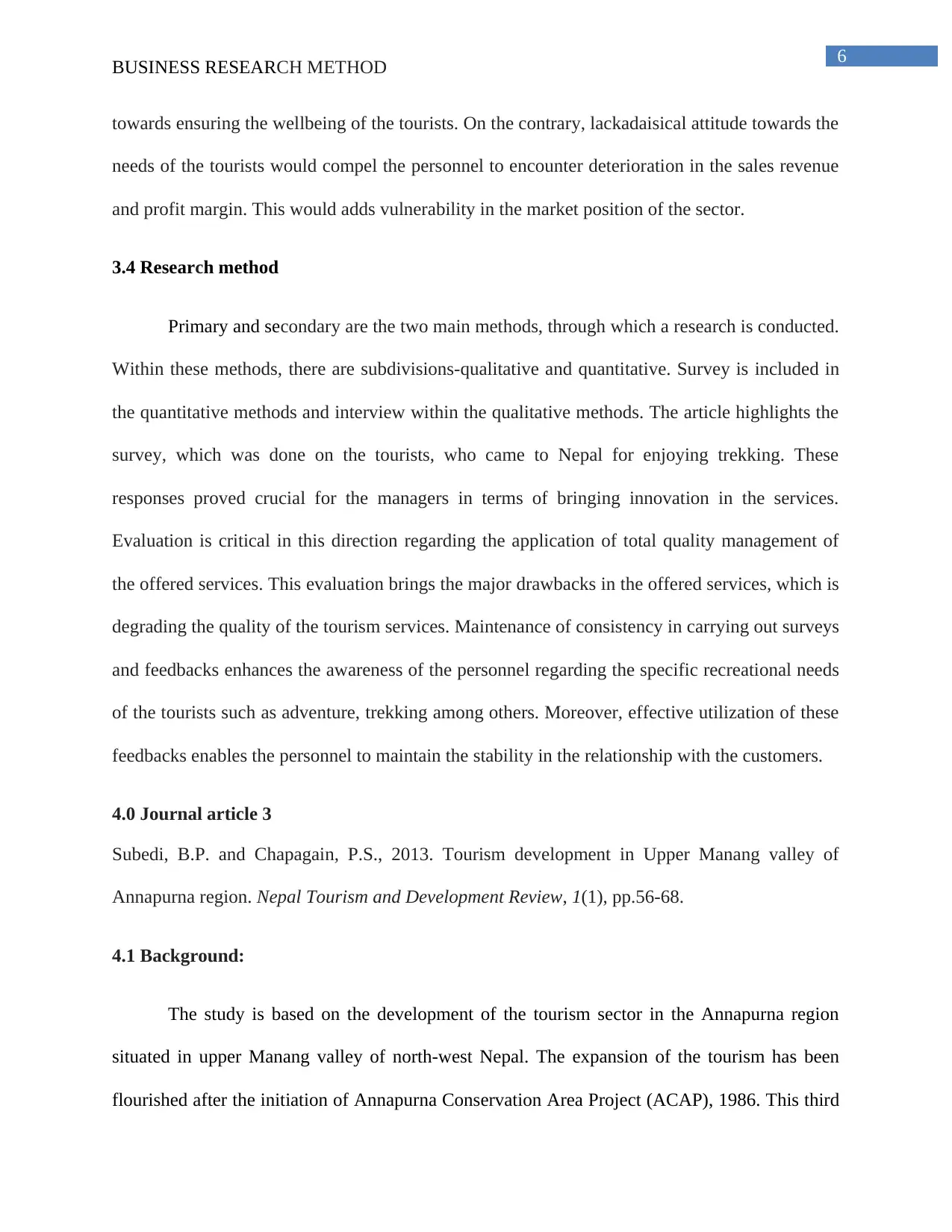
6
BUSINESS RESEARCH METHOD
towards ensuring the wellbeing of the tourists. On the contrary, lackadaisical attitude towards the
needs of the tourists would compel the personnel to encounter deterioration in the sales revenue
and profit margin. This would adds vulnerability in the market position of the sector.
3.4 Research method
Primary and secondary are the two main methods, through which a research is conducted.
Within these methods, there are subdivisions-qualitative and quantitative. Survey is included in
the quantitative methods and interview within the qualitative methods. The article highlights the
survey, which was done on the tourists, who came to Nepal for enjoying trekking. These
responses proved crucial for the managers in terms of bringing innovation in the services.
Evaluation is critical in this direction regarding the application of total quality management of
the offered services. This evaluation brings the major drawbacks in the offered services, which is
degrading the quality of the tourism services. Maintenance of consistency in carrying out surveys
and feedbacks enhances the awareness of the personnel regarding the specific recreational needs
of the tourists such as adventure, trekking among others. Moreover, effective utilization of these
feedbacks enables the personnel to maintain the stability in the relationship with the customers.
4.0 Journal article 3
Subedi, B.P. and Chapagain, P.S., 2013. Tourism development in Upper Manang valley of
Annapurna region. Nepal Tourism and Development Review, 1(1), pp.56-68.
4.1 Background:
The study is based on the development of the tourism sector in the Annapurna region
situated in upper Manang valley of north-west Nepal. The expansion of the tourism has been
flourished after the initiation of Annapurna Conservation Area Project (ACAP), 1986. This third
BUSINESS RESEARCH METHOD
towards ensuring the wellbeing of the tourists. On the contrary, lackadaisical attitude towards the
needs of the tourists would compel the personnel to encounter deterioration in the sales revenue
and profit margin. This would adds vulnerability in the market position of the sector.
3.4 Research method
Primary and secondary are the two main methods, through which a research is conducted.
Within these methods, there are subdivisions-qualitative and quantitative. Survey is included in
the quantitative methods and interview within the qualitative methods. The article highlights the
survey, which was done on the tourists, who came to Nepal for enjoying trekking. These
responses proved crucial for the managers in terms of bringing innovation in the services.
Evaluation is critical in this direction regarding the application of total quality management of
the offered services. This evaluation brings the major drawbacks in the offered services, which is
degrading the quality of the tourism services. Maintenance of consistency in carrying out surveys
and feedbacks enhances the awareness of the personnel regarding the specific recreational needs
of the tourists such as adventure, trekking among others. Moreover, effective utilization of these
feedbacks enables the personnel to maintain the stability in the relationship with the customers.
4.0 Journal article 3
Subedi, B.P. and Chapagain, P.S., 2013. Tourism development in Upper Manang valley of
Annapurna region. Nepal Tourism and Development Review, 1(1), pp.56-68.
4.1 Background:
The study is based on the development of the tourism sector in the Annapurna region
situated in upper Manang valley of north-west Nepal. The expansion of the tourism has been
flourished after the initiation of Annapurna Conservation Area Project (ACAP), 1986. This third
Paraphrase This Document
Need a fresh take? Get an instant paraphrase of this document with our AI Paraphraser
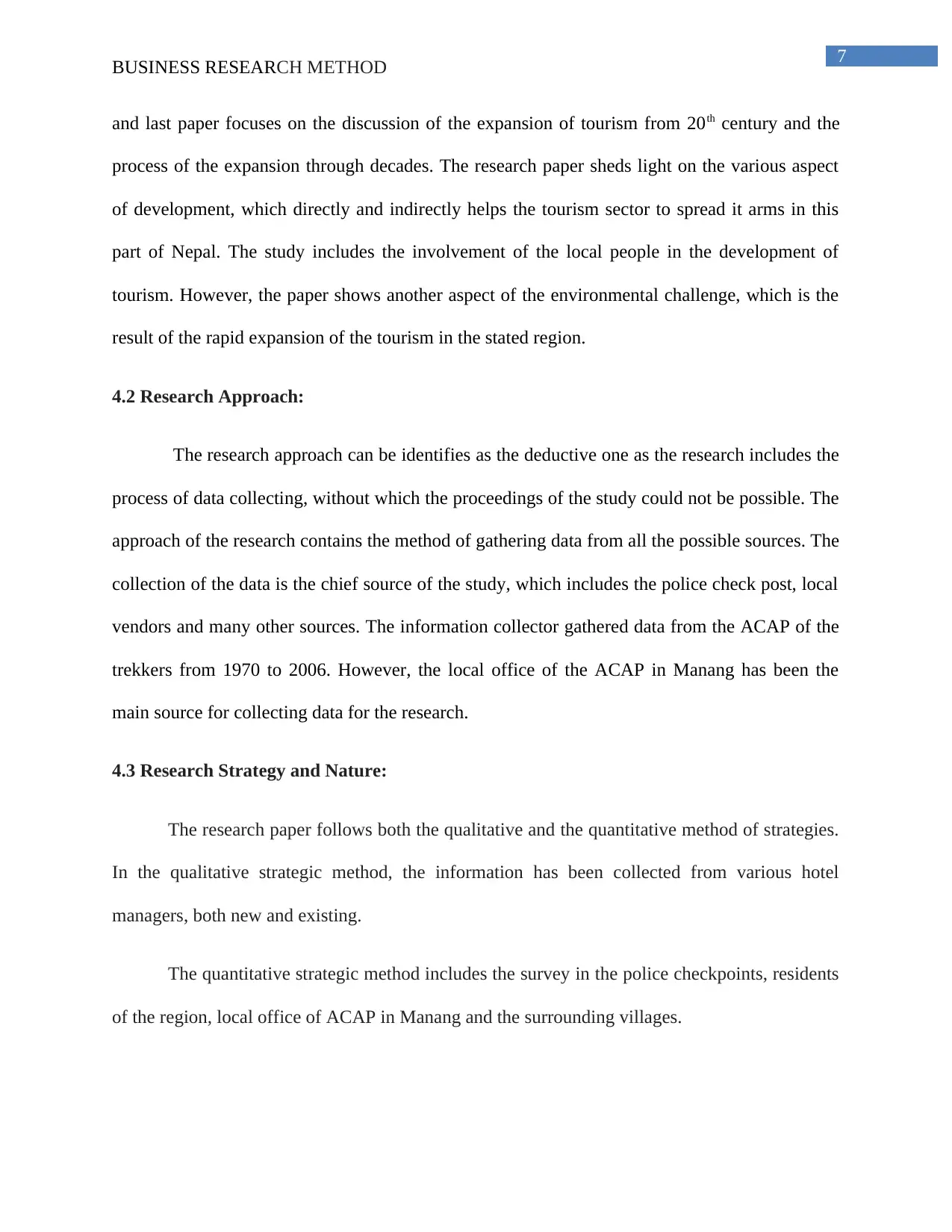
7
BUSINESS RESEARCH METHOD
and last paper focuses on the discussion of the expansion of tourism from 20th century and the
process of the expansion through decades. The research paper sheds light on the various aspect
of development, which directly and indirectly helps the tourism sector to spread it arms in this
part of Nepal. The study includes the involvement of the local people in the development of
tourism. However, the paper shows another aspect of the environmental challenge, which is the
result of the rapid expansion of the tourism in the stated region.
4.2 Research Approach:
The research approach can be identifies as the deductive one as the research includes the
process of data collecting, without which the proceedings of the study could not be possible. The
approach of the research contains the method of gathering data from all the possible sources. The
collection of the data is the chief source of the study, which includes the police check post, local
vendors and many other sources. The information collector gathered data from the ACAP of the
trekkers from 1970 to 2006. However, the local office of the ACAP in Manang has been the
main source for collecting data for the research.
4.3 Research Strategy and Nature:
The research paper follows both the qualitative and the quantitative method of strategies.
In the qualitative strategic method, the information has been collected from various hotel
managers, both new and existing.
The quantitative strategic method includes the survey in the police checkpoints, residents
of the region, local office of ACAP in Manang and the surrounding villages.
BUSINESS RESEARCH METHOD
and last paper focuses on the discussion of the expansion of tourism from 20th century and the
process of the expansion through decades. The research paper sheds light on the various aspect
of development, which directly and indirectly helps the tourism sector to spread it arms in this
part of Nepal. The study includes the involvement of the local people in the development of
tourism. However, the paper shows another aspect of the environmental challenge, which is the
result of the rapid expansion of the tourism in the stated region.
4.2 Research Approach:
The research approach can be identifies as the deductive one as the research includes the
process of data collecting, without which the proceedings of the study could not be possible. The
approach of the research contains the method of gathering data from all the possible sources. The
collection of the data is the chief source of the study, which includes the police check post, local
vendors and many other sources. The information collector gathered data from the ACAP of the
trekkers from 1970 to 2006. However, the local office of the ACAP in Manang has been the
main source for collecting data for the research.
4.3 Research Strategy and Nature:
The research paper follows both the qualitative and the quantitative method of strategies.
In the qualitative strategic method, the information has been collected from various hotel
managers, both new and existing.
The quantitative strategic method includes the survey in the police checkpoints, residents
of the region, local office of ACAP in Manang and the surrounding villages.
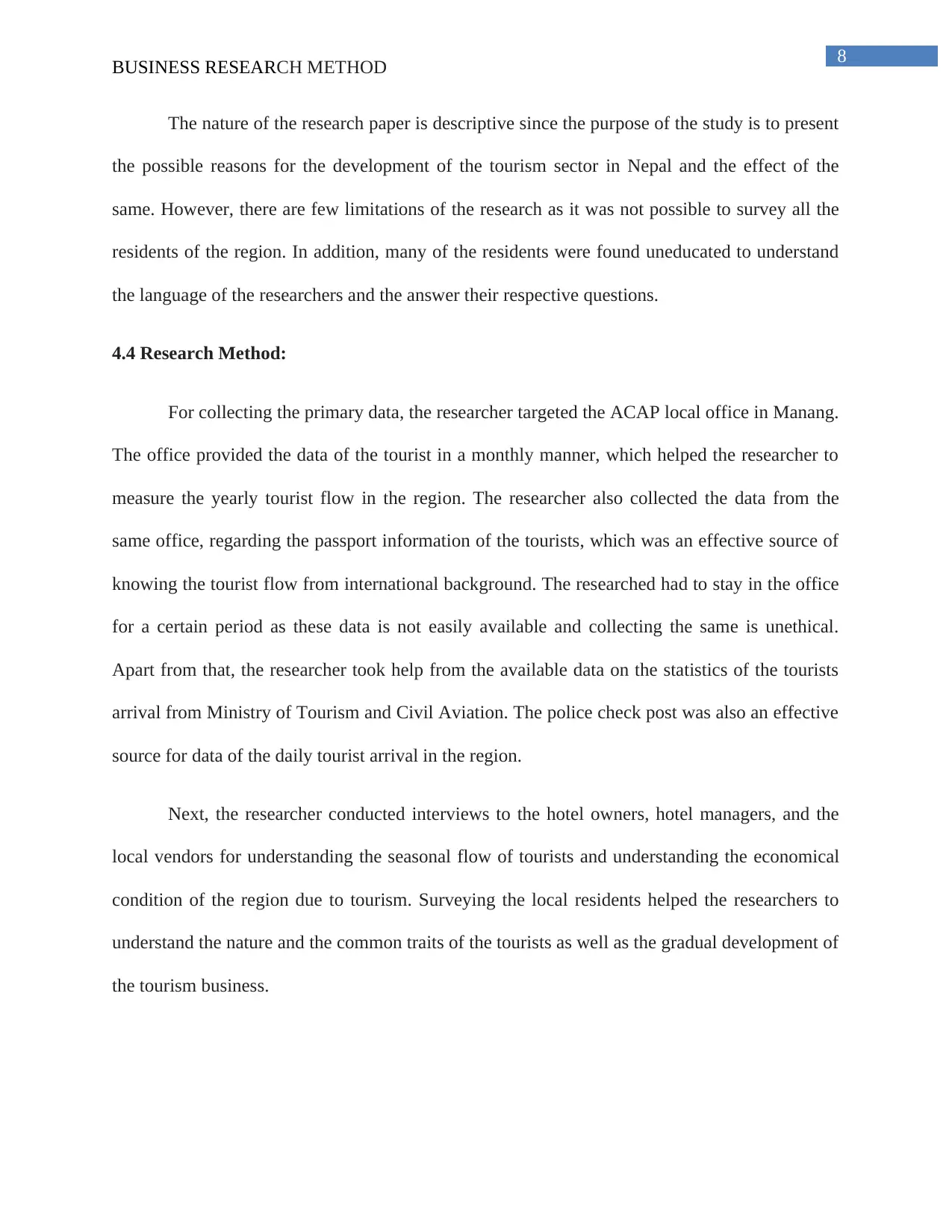
8
BUSINESS RESEARCH METHOD
The nature of the research paper is descriptive since the purpose of the study is to present
the possible reasons for the development of the tourism sector in Nepal and the effect of the
same. However, there are few limitations of the research as it was not possible to survey all the
residents of the region. In addition, many of the residents were found uneducated to understand
the language of the researchers and the answer their respective questions.
4.4 Research Method:
For collecting the primary data, the researcher targeted the ACAP local office in Manang.
The office provided the data of the tourist in a monthly manner, which helped the researcher to
measure the yearly tourist flow in the region. The researcher also collected the data from the
same office, regarding the passport information of the tourists, which was an effective source of
knowing the tourist flow from international background. The researched had to stay in the office
for a certain period as these data is not easily available and collecting the same is unethical.
Apart from that, the researcher took help from the available data on the statistics of the tourists
arrival from Ministry of Tourism and Civil Aviation. The police check post was also an effective
source for data of the daily tourist arrival in the region.
Next, the researcher conducted interviews to the hotel owners, hotel managers, and the
local vendors for understanding the seasonal flow of tourists and understanding the economical
condition of the region due to tourism. Surveying the local residents helped the researchers to
understand the nature and the common traits of the tourists as well as the gradual development of
the tourism business.
BUSINESS RESEARCH METHOD
The nature of the research paper is descriptive since the purpose of the study is to present
the possible reasons for the development of the tourism sector in Nepal and the effect of the
same. However, there are few limitations of the research as it was not possible to survey all the
residents of the region. In addition, many of the residents were found uneducated to understand
the language of the researchers and the answer their respective questions.
4.4 Research Method:
For collecting the primary data, the researcher targeted the ACAP local office in Manang.
The office provided the data of the tourist in a monthly manner, which helped the researcher to
measure the yearly tourist flow in the region. The researcher also collected the data from the
same office, regarding the passport information of the tourists, which was an effective source of
knowing the tourist flow from international background. The researched had to stay in the office
for a certain period as these data is not easily available and collecting the same is unethical.
Apart from that, the researcher took help from the available data on the statistics of the tourists
arrival from Ministry of Tourism and Civil Aviation. The police check post was also an effective
source for data of the daily tourist arrival in the region.
Next, the researcher conducted interviews to the hotel owners, hotel managers, and the
local vendors for understanding the seasonal flow of tourists and understanding the economical
condition of the region due to tourism. Surveying the local residents helped the researchers to
understand the nature and the common traits of the tourists as well as the gradual development of
the tourism business.
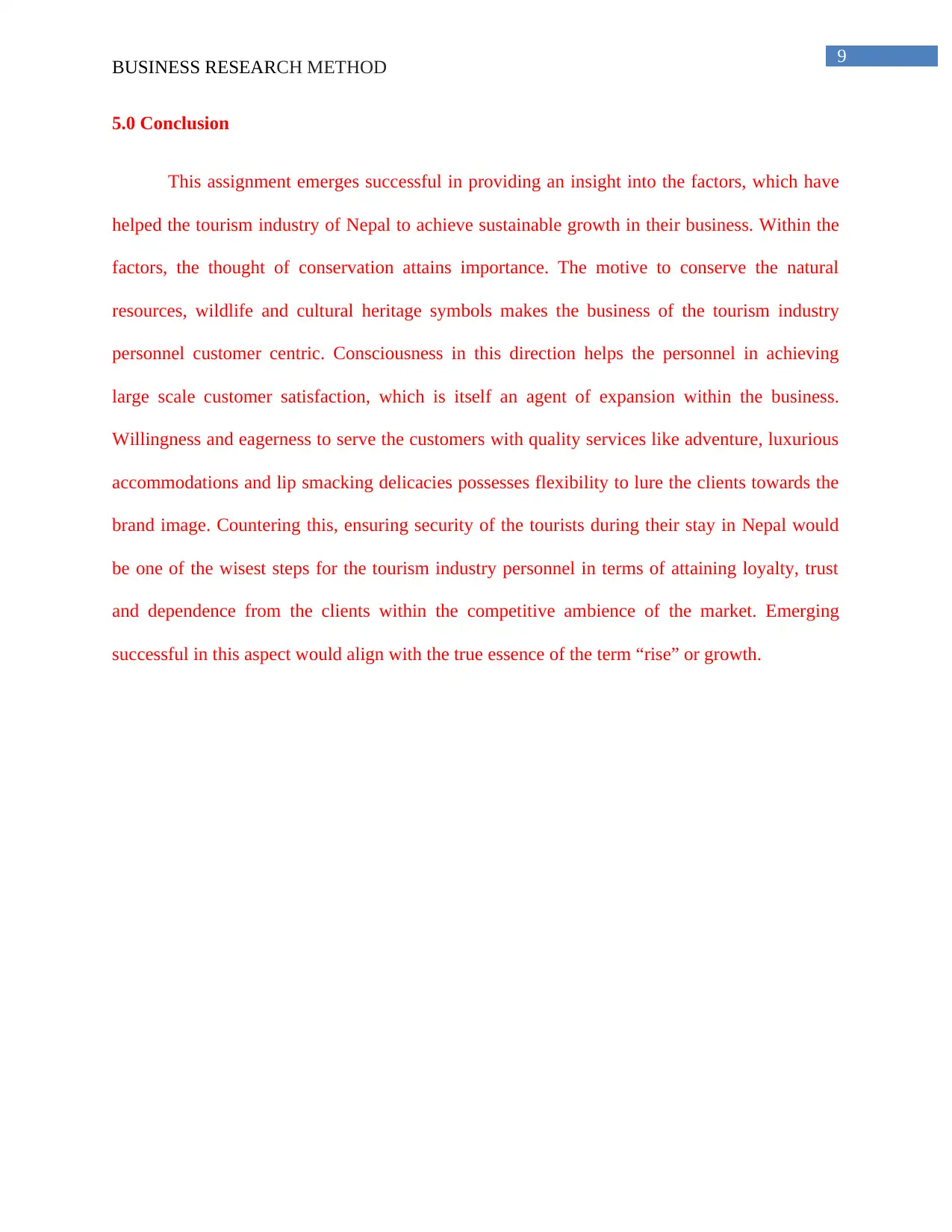
9
BUSINESS RESEARCH METHOD
5.0 Conclusion
This assignment emerges successful in providing an insight into the factors, which have
helped the tourism industry of Nepal to achieve sustainable growth in their business. Within the
factors, the thought of conservation attains importance. The motive to conserve the natural
resources, wildlife and cultural heritage symbols makes the business of the tourism industry
personnel customer centric. Consciousness in this direction helps the personnel in achieving
large scale customer satisfaction, which is itself an agent of expansion within the business.
Willingness and eagerness to serve the customers with quality services like adventure, luxurious
accommodations and lip smacking delicacies possesses flexibility to lure the clients towards the
brand image. Countering this, ensuring security of the tourists during their stay in Nepal would
be one of the wisest steps for the tourism industry personnel in terms of attaining loyalty, trust
and dependence from the clients within the competitive ambience of the market. Emerging
successful in this aspect would align with the true essence of the term “rise” or growth.
BUSINESS RESEARCH METHOD
5.0 Conclusion
This assignment emerges successful in providing an insight into the factors, which have
helped the tourism industry of Nepal to achieve sustainable growth in their business. Within the
factors, the thought of conservation attains importance. The motive to conserve the natural
resources, wildlife and cultural heritage symbols makes the business of the tourism industry
personnel customer centric. Consciousness in this direction helps the personnel in achieving
large scale customer satisfaction, which is itself an agent of expansion within the business.
Willingness and eagerness to serve the customers with quality services like adventure, luxurious
accommodations and lip smacking delicacies possesses flexibility to lure the clients towards the
brand image. Countering this, ensuring security of the tourists during their stay in Nepal would
be one of the wisest steps for the tourism industry personnel in terms of attaining loyalty, trust
and dependence from the clients within the competitive ambience of the market. Emerging
successful in this aspect would align with the true essence of the term “rise” or growth.
Secure Best Marks with AI Grader
Need help grading? Try our AI Grader for instant feedback on your assignments.
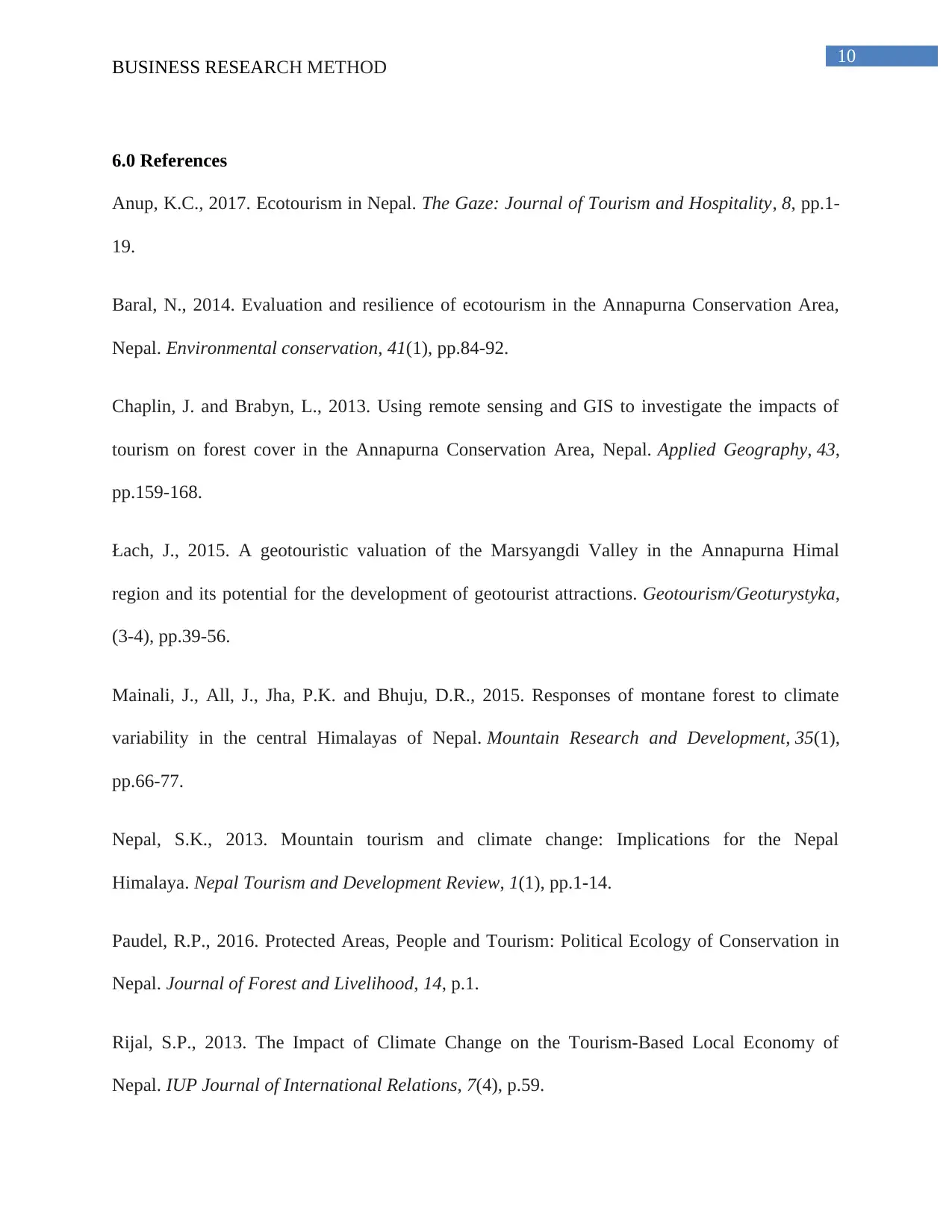
10
BUSINESS RESEARCH METHOD
6.0 References
Anup, K.C., 2017. Ecotourism in Nepal. The Gaze: Journal of Tourism and Hospitality, 8, pp.1-
19.
Baral, N., 2014. Evaluation and resilience of ecotourism in the Annapurna Conservation Area,
Nepal. Environmental conservation, 41(1), pp.84-92.
Chaplin, J. and Brabyn, L., 2013. Using remote sensing and GIS to investigate the impacts of
tourism on forest cover in the Annapurna Conservation Area, Nepal. Applied Geography, 43,
pp.159-168.
Łach, J., 2015. A geotouristic valuation of the Marsyangdi Valley in the Annapurna Himal
region and its potential for the development of geotourist attractions. Geotourism/Geoturystyka,
(3-4), pp.39-56.
Mainali, J., All, J., Jha, P.K. and Bhuju, D.R., 2015. Responses of montane forest to climate
variability in the central Himalayas of Nepal. Mountain Research and Development, 35(1),
pp.66-77.
Nepal, S.K., 2013. Mountain tourism and climate change: Implications for the Nepal
Himalaya. Nepal Tourism and Development Review, 1(1), pp.1-14.
Paudel, R.P., 2016. Protected Areas, People and Tourism: Political Ecology of Conservation in
Nepal. Journal of Forest and Livelihood, 14, p.1.
Rijal, S.P., 2013. The Impact of Climate Change on the Tourism-Based Local Economy of
Nepal. IUP Journal of International Relations, 7(4), p.59.
BUSINESS RESEARCH METHOD
6.0 References
Anup, K.C., 2017. Ecotourism in Nepal. The Gaze: Journal of Tourism and Hospitality, 8, pp.1-
19.
Baral, N., 2014. Evaluation and resilience of ecotourism in the Annapurna Conservation Area,
Nepal. Environmental conservation, 41(1), pp.84-92.
Chaplin, J. and Brabyn, L., 2013. Using remote sensing and GIS to investigate the impacts of
tourism on forest cover in the Annapurna Conservation Area, Nepal. Applied Geography, 43,
pp.159-168.
Łach, J., 2015. A geotouristic valuation of the Marsyangdi Valley in the Annapurna Himal
region and its potential for the development of geotourist attractions. Geotourism/Geoturystyka,
(3-4), pp.39-56.
Mainali, J., All, J., Jha, P.K. and Bhuju, D.R., 2015. Responses of montane forest to climate
variability in the central Himalayas of Nepal. Mountain Research and Development, 35(1),
pp.66-77.
Nepal, S.K., 2013. Mountain tourism and climate change: Implications for the Nepal
Himalaya. Nepal Tourism and Development Review, 1(1), pp.1-14.
Paudel, R.P., 2016. Protected Areas, People and Tourism: Political Ecology of Conservation in
Nepal. Journal of Forest and Livelihood, 14, p.1.
Rijal, S.P., 2013. The Impact of Climate Change on the Tourism-Based Local Economy of
Nepal. IUP Journal of International Relations, 7(4), p.59.
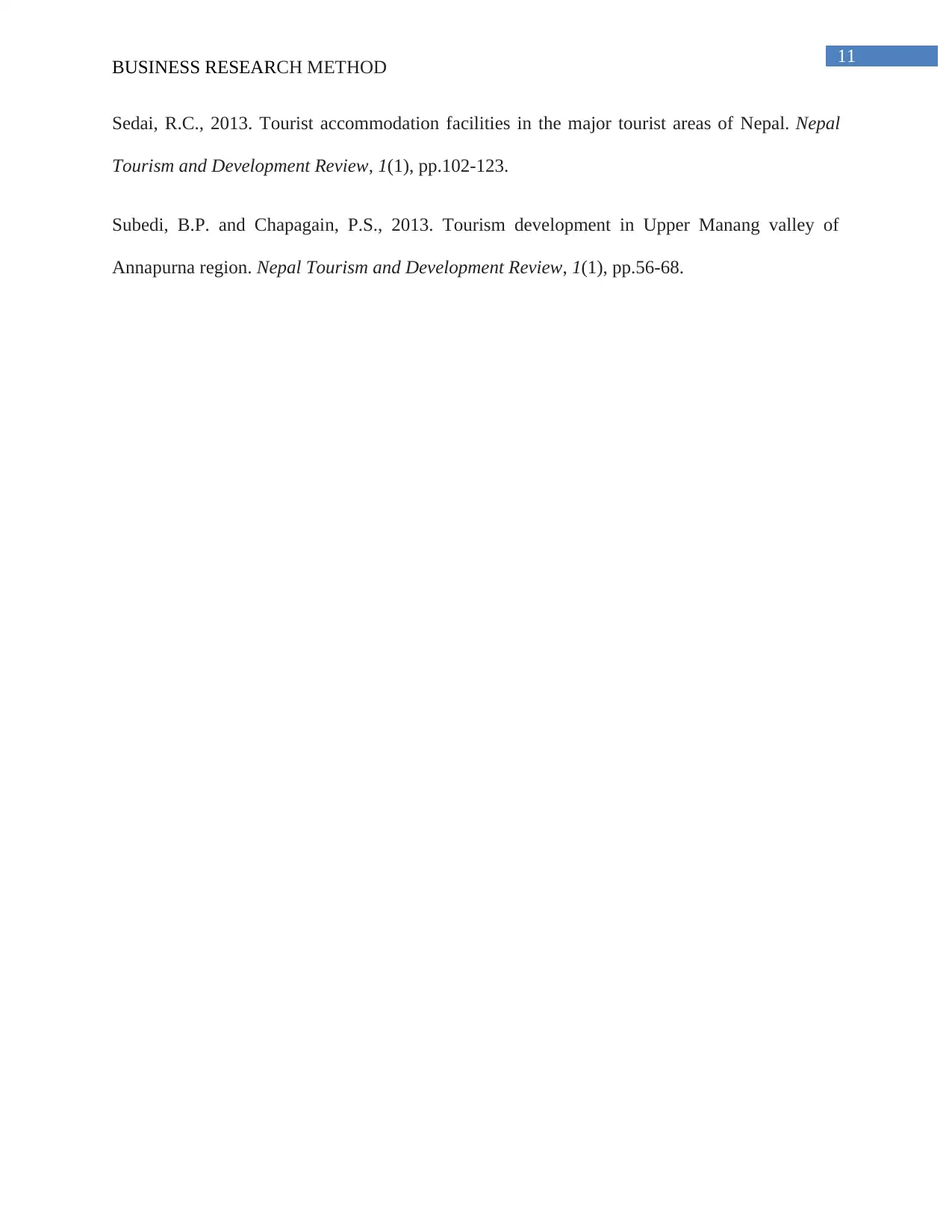
11
BUSINESS RESEARCH METHOD
Sedai, R.C., 2013. Tourist accommodation facilities in the major tourist areas of Nepal. Nepal
Tourism and Development Review, 1(1), pp.102-123.
Subedi, B.P. and Chapagain, P.S., 2013. Tourism development in Upper Manang valley of
Annapurna region. Nepal Tourism and Development Review, 1(1), pp.56-68.
BUSINESS RESEARCH METHOD
Sedai, R.C., 2013. Tourist accommodation facilities in the major tourist areas of Nepal. Nepal
Tourism and Development Review, 1(1), pp.102-123.
Subedi, B.P. and Chapagain, P.S., 2013. Tourism development in Upper Manang valley of
Annapurna region. Nepal Tourism and Development Review, 1(1), pp.56-68.
1 out of 12
Your All-in-One AI-Powered Toolkit for Academic Success.
+13062052269
info@desklib.com
Available 24*7 on WhatsApp / Email
![[object Object]](/_next/static/media/star-bottom.7253800d.svg)
Unlock your academic potential
© 2024 | Zucol Services PVT LTD | All rights reserved.